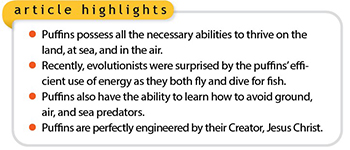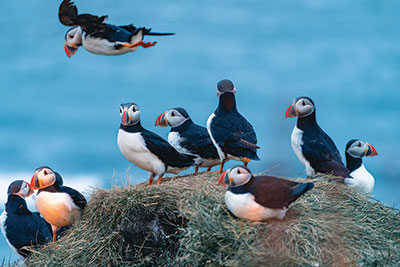 In order for tufted, horned, and Atlantic puffins to “be fruitful, multiply, and fill” specific habitats on Earth,1 they need the right equipment. That requires God-given design bioengineering fitted for interfacing with dynamic conditions of habitats that they will “fill.”1,2 As living exhibits, puffins present God’s “clearly seen” handiwork and glory.2
In order for tufted, horned, and Atlantic puffins to “be fruitful, multiply, and fill” specific habitats on Earth,1 they need the right equipment. That requires God-given design bioengineering fitted for interfacing with dynamic conditions of habitats that they will “fill.”1,2 As living exhibits, puffins present God’s “clearly seen” handiwork and glory.2
Thanks to Christ’s providential bioengineering, puffins have the right equipment—for continuous environmental tracking (CET)—fit for living in the cold coastlands and northern seas of the Atlantic and Pacific Oceans.2-4
Some puffin CET traits are physical, such as anatomical parts and physiological systems needed for activities on land, in water, and in air. Yet other CET traits are intangible, such as gaining and/or applying know-how (and know-when)—what the Bible calls “received wisdom”5—when making life-protecting decisions in real time to avoid hungry predators.
Bioengineered Bodies for Land, Air, and Sea
Some evolutionists recently studied and videographed the flying behaviors of puffins, plus their biophysical movements in ocean-water diving and swimming underwater.4 The results surprised them; these constantly moving clown-looking birds exhibited metabolic energy efficiency, for hours and days, in both air and ocean habitats.4
Yet creationists were not surprised because the Lord Jesus bioengineered puffins to move efficiently in both fluids—liquid seawater and gaseous air currents—minimizing wasted metabolic energy, even in a fallen world.4
Providentially Programmed for Wise Decision-Based Behaviors
 Puffins avoid many bird-eating predators simply by flying to and from island clifftop heights that are inaccessible to four-footed carnivores such as dogs, foxes, cats, river otters, martens, and rats.3 However, seals may attack puffins underwater, so puffins must stay alert for more than fish whenever they are fishing underwater. Moreover, puffins keep alert eyes whenever flying because airborne predators include eagles, hawks, skuas, and large gulls—with the great black-backed gull being the most threatening.3
Puffins avoid many bird-eating predators simply by flying to and from island clifftop heights that are inaccessible to four-footed carnivores such as dogs, foxes, cats, river otters, martens, and rats.3 However, seals may attack puffins underwater, so puffins must stay alert for more than fish whenever they are fishing underwater. Moreover, puffins keep alert eyes whenever flying because airborne predators include eagles, hawks, skuas, and large gulls—with the great black-backed gull being the most threatening.3
Yet puffins are wise—they learn.5 Many puffins, such as some whom this writer observed on Staffa, an island in the Hebrides, have somehow learned that settling in clifftop grasses near human tourists is a safe place because predatory seagulls are reluctant to land on clifftops where humans are present.3
Puffin preferences show endowed intelligence, not trial-and-error random actions. Puffins acquire affinity for human hikers rather than for seagulls. This fits the Bible’s teaching that God gives learning ability—"wisdom"— to diverse animals.2,3,5 Thus, puffins display Christ’s caring providence.2
The Lord Jesus wisely endowed puffins with helpful traits—physical bodies for interfacing with air and sea plus learning abilities—so they can recognize human “neighbors” as a cue showing where to land safe from predatory seagulls.
References
- Humans were commanded after the Flood to “be fruitful, multiply, and fill the earth” (Genesis 9:1-7). However, God’s general plan for animals differs. Specifically, post-Flood animals are to “breed abundantly…be fruitful, and multiply upon the earth” (Genesis 8:17), yet apparently doing so within biomes and habitat ranges that are biogeographically less comprehensive than those of humans, who are more biogeographically versatile, often using habitat-dominating technologies. See Moore, P. D., ed. 1987. The Encyclopedia of Animal Ecology. New York: Equinox Books, 4-13, 33-41, 116-143.
- Compare Job 12:7-10 with Romans 1:20. “Biological anticipatory systems are real, and creatures use them to closely track environmental changes.…For those with eyes to see, [these CET systems] burst with such purpose-driven activity that both the genius and tender provision of their Creator, the Lord Jesus Christ, are clearly seen.” Guliuzza, R. J. 2019. Engineered Adaptability: Creatures’ Anticipatory Systems Forecast and Track Changes. Acts & Facts. 48 (3): 16-18.
- This author observed resting Atlantic puffins on July 19, 2019, at very close range (about four feet away) on the island of Staffa in the Scottish Hebrides. Consistent with similar reports by others, the puffins at Staffa were unafraid to rest very close to humans visiting Staffa’s cliffside heights and seemed attracted to nearby humans because humans intimidated the arrival of great black-backed gulls—the most threatening natural predator of Atlantic puffins. Accordingly, many puffins flew up to the cliffsides where humans were gathered, landed at the island’s clifftop edges, and settled in grasses and rocks very close to the humans as great black-backed gulls flew above nearby, deterred from approaching these “protected” puffins.
- Johnson, J. J. S. Alaskan Alcids: Efficiently Designed for Air and Water. Creation Science Update. Posted on ICR.org July 20, 2020, accessed October 29, 2021. Quoting Lapsansky, A., D. Zatz, and B. W. Tobalske. 2020. Alcids ‘fly’ at efficient Strouhal numbers in both air and water, but vary stroke velocity and angle. eLife. 9: e55774.
- Regarding birds using “wisdom,” see Johnson J. J. S. 2017. Clever Creatures: “Wise from Receiving Wisdom.” Acts & Facts. 46 (3): 21.
* Dr. Johnson is Associate Professor of Apologetics and Chief Academic Officer at the Institute for Creation Research.













